
Kathmandu Vs North Face (The Definitive Guide)
By Unlock Wilderness
20th April 2023
Are you ready to gear up for the cold, but stuck wondering if you should go for a Kathmandu or North Face jacket? We've all been there – choosing between two top-notch brands can be a daunting task. But don't worry, we've got you covered!
In this article, we'll dive deep into the world of down and insulated jackets and compare the best of the best – Kathmandu and North Face. So, whether you're looking for warmth or style (or both), sit tight and read on, because by the end of this, you'll know which brand deserves a spot in your wardrobe.
This post contains affiliate links; as an Amazon Associate we earn commission from qualifying purchases.
Kathmandu Vs North Face
Materials and Manufacturing
When it comes to buying a down or insulated jacket, the materials used and the manufacturing processes play a crucial role in the quality and durability of the product. Kathmandu and North Face are two well-known outdoor apparel brands that offer a range of jackets with a variety of features, but how do their materials and manufacturing processes stack up against each other?
Let's start with the materials used. Both brands use high-quality materials to ensure their jackets are warm, lightweight, and comfortable to wear. Kathmandu uses ethically-sourced down, which is a natural insulator that provides excellent warmth without adding excess weight. They also use synthetic materials such as PrimaLoft, which provides exceptional warmth and moisture management, making it perfect for wet conditions.
On the other hand, North Face uses a mix of natural and synthetic materials in their jackets. They use responsibly-sourced down, which is certified by the Responsible Down Standard, and also use synthetic materials such as ThermoBall, which mimics the warmth of down but with the added benefit of being water-resistant.
In terms of manufacturing processes, both Kathmandu and North Face take great care to ensure their products are made to the highest standards. Each brand employs a range of manufacturing techniques, including baffle construction, seamless bonding, and heat-sealed seams, which help to eliminate cold spots and improve insulation.
However, there are a few key differences between the two brands when it comes to manufacturing. Kathmandu uses fully-certified factories that meet strict ethical and environmental standards, and they also have a range of sustainability initiatives in place. Meanwhile, North Face has a strong focus on innovation and technology, and they use a range of advanced manufacturing processes, such as fused seams and pattern cutting, to improve the fit and performance of their jackets.
In conclusion, both Kathmandu and North Face use high-quality materials and advanced manufacturing processes to create durable and high-performance jackets. While each brand has its own unique approach, the choice ultimately comes down to personal preference and which features matter most to you.
Design and Features
When it comes to outdoor jackets, design and features are important factors that can make or break the functionality of the jacket. And when it comes to comparing Kathmandu and North Face's down and insulated jackets, there are some notable differences in the design and features.
Let's start with North Face. Their jackets are known for their sleek and stylish designs, and their focus on practical features. For example, many of their jackets come with hoods that are adjustable, allowing you to customize the fit for your head. This is particularly useful in windy or rainy conditions, where you need the added protection. Additionally, many of their jackets come with a variety of pockets, including chest, hand, and sleeve pockets for added convenience.
Kathmandu jackets are also designed with practicality in mind, but they tend to be more robust and heavy-duty in their construction. Their focus is on creating jackets that are durable and can withstand tough outdoor conditions. They also offer a wide range of features, such as adjustable cuffs and hems, ventilated pockets, and reinforced stitching. Some of their jackets even offer detachable hoods, allowing you to remove them when they're not needed.
When it comes to comparing which brand offers the most useful and practical features, it really depends on your personal preferences and the kind of activities you'll be doing while wearing the jacket. North Face focuses on delivering a sleek and stylish look, while Kathmandu prioritizes durability and robustness.
Ultimately, both brands offer an impressive range of features that will suit the needs of outdoor enthusiasts. Whether you're looking for a lightweight and breathable jacket or a heavy-duty insulated option, you're bound to find something that works for you from either Kathmandu or North Face.
Performance and Durability
When it comes to performance and durability, both Kathmandu and North Face have a lot of features to offer in their down and insulated jackets. But what really sets them apart? Let's take a closer look.
Firstly, insulation is a crucial factor in any jacket that's meant to brave the cold outdoors. Both brands offer jackets with high-quality down insulation, which is meant to keep you warm without creating bulk. The difference lies in the quality of down used. North Face uses a variety of down from several regions, ensuring a high standard of insulation. On the other hand, Kathmandu uses an ethical and sustainable down filling, which not only reduces animal cruelty but also maintains its insulating qualities even when wet.
Moving to waterproofing, both brands offer jackets that are water-resistant to varying degrees. North Face uses its patented DryVent technology that creates a waterproof barrier, while Kathmandu's jackets are treated with Durable Water Repellent (DWR) for enhanced water resistance. So, if you're looking for a highly waterproof jacket, North Face is the way to go. But if you're okay with moderate water resistance and support sustainable down filling, Kathmandu might be a smarter pick.
Finally, breathability is an essential aspect of any jacket, especially during high-intensity activities like hiking. In this regard, North Face again has the edge, thanks to its breathable fabrics that keep you feeling dry and cool. However, that's not to say Kathmandu jackets fall behind. They have some performance-enhancing features like underarm zips that allow for ventilation, plus a breathable lining that lets moisture escape.
Ultimately, when it comes to performance and durability, the right choice will depend on what is important to you. Both brands offer exceptional quality, insulation, waterproofing, and breathability, but differ slightly on aspects like sustainability, animal welfare, and waterproofing technology. So be sure to consider your needs to ensure you find the perfect match!
Price and Value
When it comes to buying an insulated jacket, price and value are two huge factors to consider. On one hand, you want to get something that's affordable and won't break the bank. On the other hand, you want to invest in a high-quality jacket that will last you for years to come. So, which brand - Kathmandu or North Face - offers the best combination of price and value?
Let's start by looking at the different jackets offered by each brand. Kathmandu offers a range of down and synthetic insulation jackets, such as the Heli Women's Lightweight Down Jacket and the Men's Epiq Hooded Down Jacket. North Face follows suit with its own range of insulated jackets, such as the Women's Gotham Jacket and the Men's McMurdo Parka III.
In terms of price, Kathmandu's jackets start at around $150 and go up to $600 for their premium models. Meanwhile, North Face's jackets can range anywhere from $200 to $800. This means that both brands offer jackets at a wide range of price points, so there's something for every budget.
But when it comes to value, things start to get a little more complicated. Both brands offer excellent features such as waterproofing, wind resistance, and adjustable hoods. However, North Face is known for its high-end Gore-Tex fabrics and other technical features that make their jackets some of the toughest on the market. Kathmandu, on the other hand, prides itself on its eco-friendly materials and responsible manufacturing practices.
Ultimately, the value of each brand's jackets will depend on your personal preferences and priorities. If you're looking for a jacket that will perform well in extreme weather conditions and will last you for years to come, North Face might be the better choice. But if you want to support a brand that is committed to sustainability and ethical manufacturing practices, Kathmandu might be the way to go.
In conclusion, when it comes to choosing between Kathmandu and North Face, there is no clear winner in terms of price and value. Both brands offer a variety of models at different price points, and both have their own unique features and benefits. So, it's up to you to decide which brand offers the best value for your money based on your individual needs and preferences.
Kathmandu Vs North Face Men's Lightweight Insulated Jackets
When it comes to Men's Lightweight Insulated Jackets, both Kathmandu and The North Face offer excellent options, but there are some key differences to consider before making a purchase.
Kathmandu's Heli 600 Fill Lightweight Down Jacket is an all-around versatile solution for when weather can change frequently. It's lightweight and highly compressible, making it easy to pack in and out, while still providing ample warmth with its 600 fill power duck down insulation. The Heli jacket's durable water repellent finish also makes it a solid option in wetter conditions.
On the other hand, The North Face's ThermoBall™ Eco Jacket 2.0 is all about advanced insulation and packability. The jacket features ThermoBall™ Eco insulation, meaning it retains warmth even when wet and is highly compressible. Additionally, the entire jacket is made from 100% recycled fabrics and fill, making it a conscious choice for anyone concerned about the environment.
While both products are highly rated and excellent choices in their own right, Kathmandu's Heli jacket may be a better fit for those who want a slightly more versatile offering, whereas The North Face's ThermoBall™ Eco Jacket 2.0 is ideal for anyone looking for a highly packable, advanced insulation option that's also eco-friendly.
Ultimately, the choice between Kathmandu and The North Face will come down to the individual's preference and needs, but both brands offer an impressive range of Men's Lightweight Insulated Jackets to suit a wide range of activities and climates.

Heli 600 Fill Lightweight Down Jacket by Kathmandu
Our rating: ★★★★★
Price: $$$$
Lightweight warmth for unpredictable weather.
What makes it special? What sets this jacket apart is its versatility - it can function as either a mid or outer layer, making it a go-to choice for when weather patterns are uncertain. But don't be fooled by its lightweight construction - the Heli jacket provides ample warmth without the added bulk. The duck down insulation, complete with a 600 fill power, is independently certified to the Responsible Down Standard. And with its durable water repellent finish, any water droplets will bead off the fabric's surface. One of the standout features of this jacket is its packability. It can easily be compressed and stowed away in its own pocket, making it a perfect option for those on-the-go or with limited storage. Other helpful details include elasticated cuffs and an adjustable hem for enhanced fit and weather protection, as well as multiple pockets for storing essentials. Its outer and inner compositions are both made of durable polyester, and it comes in at a weight of just 372g (size M). It's a great choice for adventure-seekers and those looking for a jacket that can withstand changing weather conditions.
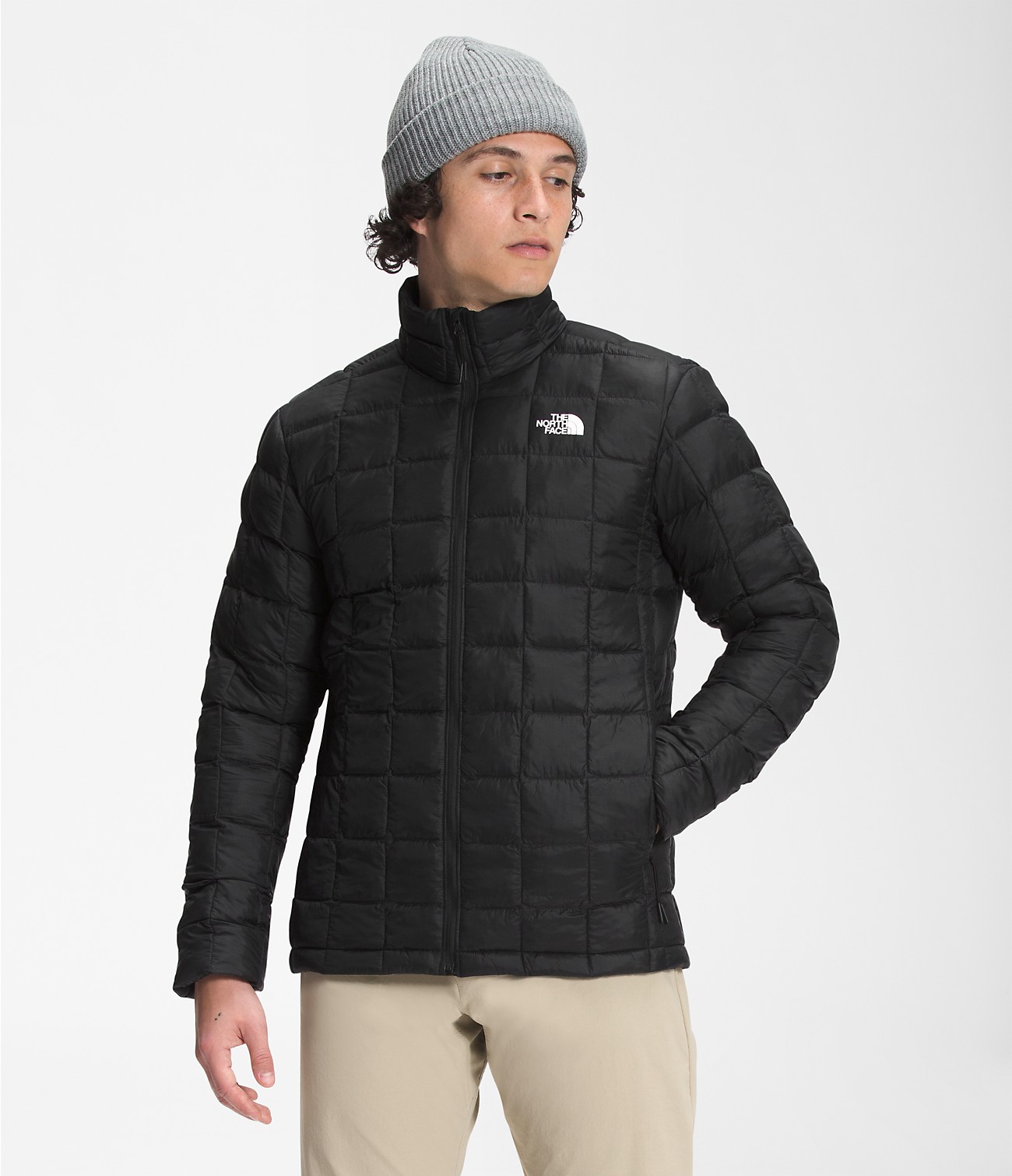
ThermoBall™ Eco Jacket 2.0 by The North Face
Our rating: ★★★★★
Price: $$$$
Lightweight warmth with sustainable style.
What makes it special? The innovative quilting pattern and advanced ThermoBall™ Eco insulation make this jacket a true standout when it comes to delivering warmth without weighing you down. One of the most impressive features of the ThermoBall™ Eco Jacket 2.0 is its packability. This jacket stows easily in its own chest pocket, making it a go-to choice for hikers, backpackers, or anyone who wants to stay warm and comfortable without carrying a bulky jacket around all day. But the ThermoBall™ Eco Jacket 2.0 isn't just practical—it's also good for the planet. The jacket is made with 100% recycled fabrics and fill, meaning that it's both tough on the cold and easier on the environment. Additionally, the slim fit and sleek design make this jacket a stylish and versatile choice for anyone. And with its impressive insulation and eco-friendly design, this jacket is the perfect choice for anyone looking to make a conscious choice about their gear.
Kathmandu Vs North Face Men's Down Jackets
If you're trying to decide between Kathmandu and The North Face for your next men's down jacket purchase, there are a few things to consider. While both brands offer high-quality products, there are some key differences worth noting.
Let's start with Kathmandu. The Epiq 600 Fill Hooded Down Jacket is a standout option from this brand. It's made with a recycled outer fabric that allows the insulation to fully loft, providing maximum warmth. It also has a durable water repellent (DWR) finish to keep you dry in wet conditions. The jacket features internal stretch cuffs, an adjustable hem, and a chin guard for added weather protection. Plus, it's made with bluesign®-approved materials, meaning it's produced with minimal impact on people and the environment.
On the other hand, The North Face's 1996 Retro Nuptse Jacket is a top pick for those who prioritize style and durability. This jacket has oversized baffles that are reminiscent of the classic Nuptse design from 1996. It's made with original shiny ripstop fabric for added durability, and has a non-PFC DWR finish. The jacket features a secure-zip hand pockets and stowable hood, making it both practical and stylish.
While both brands offer high-quality products, Kathmandu seems to be more focused on sustainability and responsible sourcing. The Epiq jacket is made with recycled materials and the brand prioritizes ethical production standards. Meanwhile, The North Face's 1996 Retro Nuptse is all about style and durability, and is perfect for those who want a jacket that looks as good as it performs.
Ultimately, the decision between Kathmandu and The North Face comes down to personal preferences. If you're looking for a sustainable option, Kathmandu is the way to go. But if you want a jacket that combines style and function, The North Face has you covered. Either way, you're sure to find a high-quality men's down jacket that meets your needs from these two top outdoor brands.

Epiq 600 Fill Hooded Down Jacket by Kathmandu
Our rating: ★★★★★
Price: $$$$
Stay warm and eco-friendly with this functional down jacket.
What makes it special? This jacket is designed to keep you warm and comfortable in the coldest weather conditions, whether you're commuting to work or exploring the great outdoors on the weekends. One of the key features of this jacket is the recycled Pertex™ Quantum Eco outer fabric, which allows the 600-fill power duck down insulation to fully loft, providing maximum warmth. The durable water repellent (DWR) finish on the outer fabric ensures that water beads off the surface, keeping you dry in wet weather. The Kathmandu Epiq jacket also features stretch cuffs and an adjustable hem, providing extra weather protection and ensuring a comfortable fit. The chin guard and inner collar with a soft, brushed fabric lining add an extra layer of comfort and warmth. In terms of storage, this jacket has you covered with two front zip pockets with soft, brushed lining, as well as an inner stash pocket and inner zip pocket with a cord port for headphones. The jacket even comes with a separate stuff sack, making it easy to pack and take on the go. Not only is the Epiq jacket functional, but it's also environmentally responsible. All of the down used in the jacket is independently certified to the Responsible Down Standard, ensuring that it was produced with minimal impact on people and the environment.
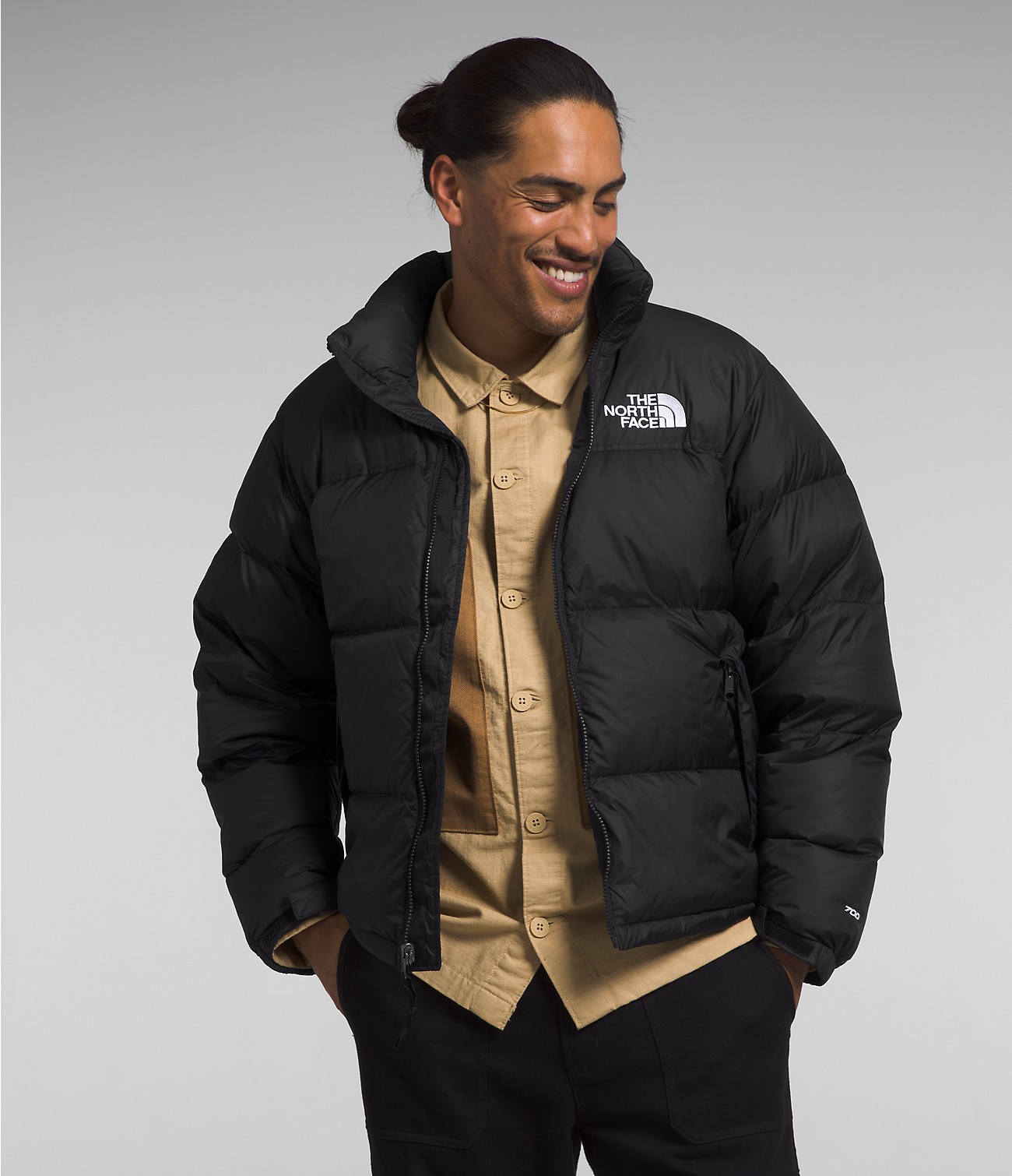
1996 Retro Nuptse Jacket by The North Face
Our rating: ★★★★★
Price: $$$$
Revolutionize your outdoor style and performance.
What makes it special? This jacket boasts a water-repellent finish, a durable design inspired by the classic 1996 Nuptse Jacket, and 100% recycled fabrics. One of the most eye-catching features of this jacket is the oversized baffles, which add an element of style to the design. Plus, the 700-fill goose down offers an exceptional warmth-to-weight ratio, making it a versatile jacket that can handle cold weather with ease. The attached, stowable hood and secure-zip hand pockets are also great touches that add to the practicality of this jacket. Not to mention, the Triclimate® loops for snap-in compatibility allow this jacket to work seamlessly with other compatible gear from The North Face. It's stylish, practical, and incredibly durable - everything you need to take on any outdoor adventure.
Kathmandu Vs North Face Women's Lightweight Insulated Jackets
Choosing between Kathmandu and The North Face for your Women's Lightweight Insulated Jacket needs can be tough, but here's a comparison to help you decide. On the one hand, Kathmandu's Heli 600 Fill Lightweight Down Jacket offers versatility, high-quality materials, and a pack&GO solution that's perfect for those on the move, while on the other hand, The North Face's ThermoBall™ Eco Hoodie 2.0 boasts advanced insulation technology that keeps you warm even when wet, eco-friendliness, and a slim fit that's flattering and easy to wear. Ultimately, it comes down to your personal preferences and what features matter most to you.
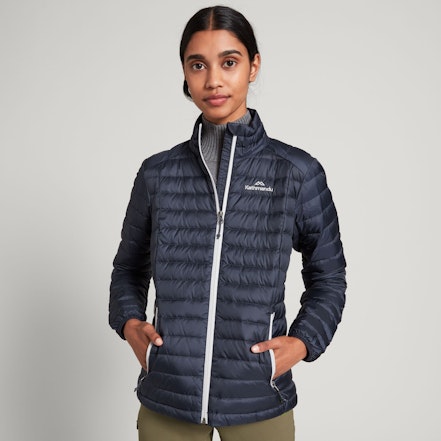
Heli 600 Fill Lightweight Down Jacket by Kathmandu
Our rating: ★★★★★
Price: $$$$
Versatile, lightweight, and warm - the perfect outdoor companion.
What makes it special? This jacket is the perfect choice for those who need a reliable outer layer that can handle whatever nature throws their way, and it's an ideal option for anyone who loves outdoor activities like hiking, camping, and skiing. Whether you need an extra layer of warmth on a chilly day or a lightweight jacket for a mild spring evening, the Heli Down Jacket has you covered. Another advantage of this jacket is its compact design. The Kathmandu pack&GO solution means that you can easily pack this jacket into its own pocket, saving you valuable space in your backpack or luggage. The lightweight and easily compressible design of the jacket means that you'll barely notice it's there, which is perfect for those on the move. The Kathmandu Heli 600 Fill Lightweight Down Jacket is also made of high-quality materials. All of the down is independently certified to the Responsible Down Standard, ensuring that it is ethically sourced. Additionally, the jacket features a Durable Water Repellent (DWR) finish, which encourages water to bead off the fabric's surface. This means that the jacket will keep you dry and warm, even in rainy or snowy conditions. With a full front zip, chin guard, adjustable hem, and elasticated cuffs, you'll enjoy an enhanced fit and weather protection, ensuring maximum comfort and warmth at all times. The jacket also features two front zip pockets and two large inner stash ones, providing ample storage for all your essentials.
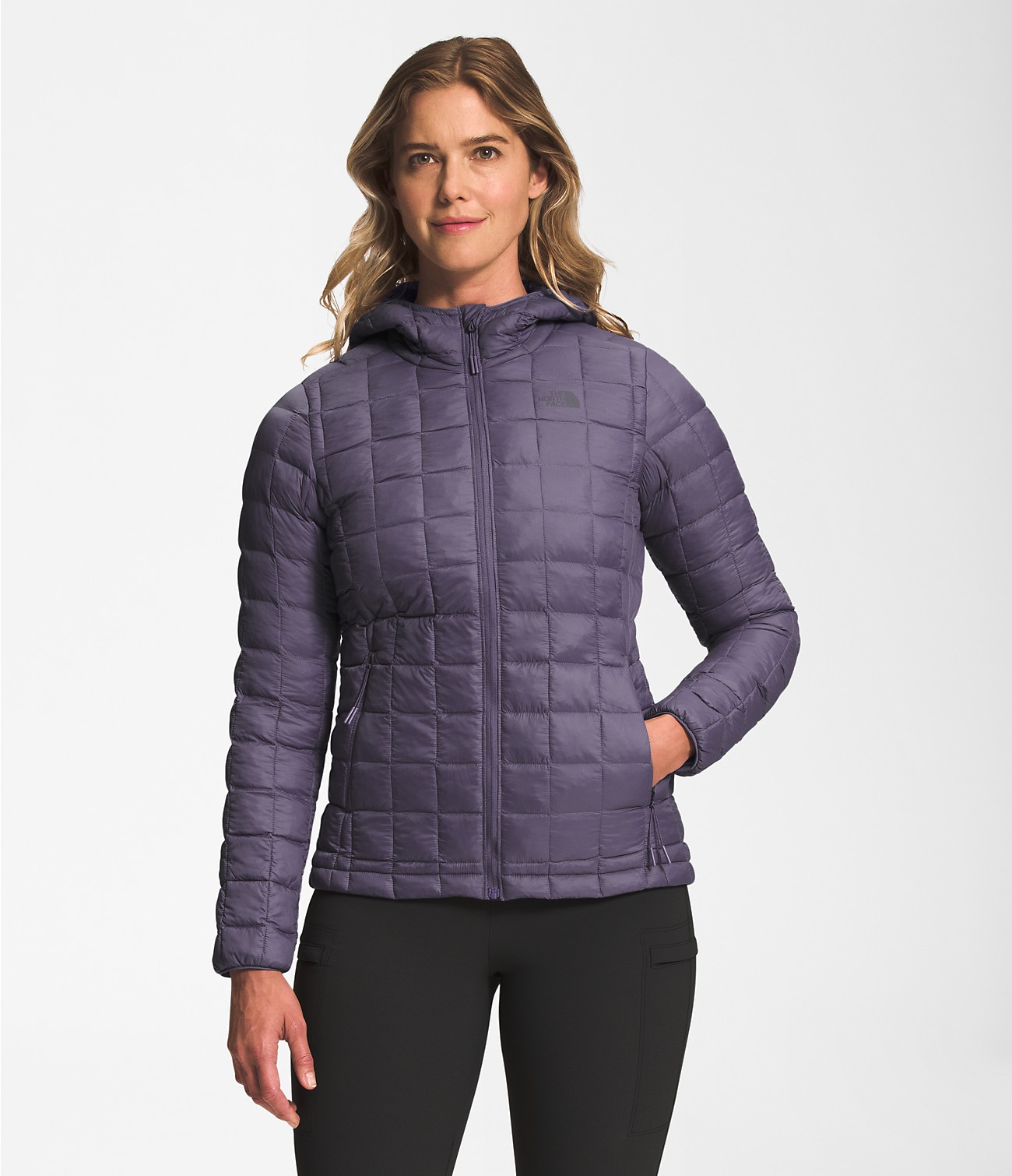
ThermoBall™ Eco Hoodie 2.0 by The North Face
Our rating: ★★★★★
Price: $$$$
Eco-friendly insulation for the modern traveler.
What makes it special? Not only does it boast advanced insulation technology that keeps you warm even when wet, but it's made with 100% recycled fabrics and fill, making it eco-friendly and sustainable. One of the standout features of this jacket is its slim fit, which is flattering and easy to wear. The 2x2 quilt pattern not only adds a touch of style, but also helps to evenly distribute the insulation, ensuring maximum warmth. And with an attached hood and reverse-coil center front zip, you can stay warm and protected from the elements. When you're not wearing the jacket, it stows neatly in the chest pocket, making it easy to pack and travel with. And with concealed, secure-zip hand pockets, you can keep your essentials close at hand. Plus, the unique variations in fabric color and texture mean that every jacket is one-of-a-kind.
Kathmandu Vs North Face Women's Down Jackets
When it comes to women's down jackets, Kathmandu and The North Face are two of the most popular and reputable brands on the market. Both brands offer a range of high-quality options, but there are a few key differences to consider when trying to decide between the two.
Let's take a closer look at the reviewed products:
The Kathmandu Epiq 600 Fill Hooded Down Jacket is a classic puffer with a recycled Pertex™ Quantum Eco outer fabric and 600-fill power duck down. It also features adjustable hood, internal stretch cuffs, and inner and outer fabric that meets bluesign® criteria. This jacket is a great option for those looking for warmth and responsibility in their outerwear.
On the other hand, The North Face Women's 1996 Retro Nuptse Jacket features a relaxed fit with a boxy silhouette and 700 fill goose down. It has an original shiny ripstop fabric for durability and oversized baffles for warmth. This jacket is a throwback design inspired by the iconic 1996 Nuptse jacket and is perfect for both mountain and city life.
So, how do these two offerings compare? Firstly, the Kathmandu Epiq has a more responsible approach, with recycled materials and independent certification for down. The North Face Women's 1996 Retro Nuptse Jacket, however, has a more classic and timeless design. In terms of features, both jackets have adjustable hoods and cuffs, as well as environmental considerations. However, The North Face jacket also has an attached, stowable, three-piece hood, Secure-zip hand pockets, and Triclimate loops.
Ultimately, choosing between Kathmandu and The North Face depends on your specific needs and preferences. If you want a jacket that's more focused on sustainability and responsibility, the Kathmandu Epiq 600 Fill Hooded Down Jacket is an excellent choice. If you want a jacket that combines a classic look with practical features, the Women's 1996 Retro Nuptse Jacket from The North Face may be more up your alley.
At the end of the day, both brands offer high-quality choices that provide both warmth and protection from the elements. So whichever one you choose, you're sure to be well-equipped for your next big adventure.

Epiq 600 Fill Hooded Down Jacket by Kathmandu
Our rating: ★★★★★
Price: $$$$
Stay warm and stylish on your outdoor adventures.
What makes it special? Firstly, the recycled Pertex™ Quantum Eco outer fabric is a great feature. It not only allows the insulation to fully loft, but it's also durable and has a DWR finish that encourages water to bead off the fabric's surface. Combined with 600-fill power duck down, this jacket provides maximum warmth and protection from the elements. And speaking of elements, the adjustable hood and hem, inner stretch cuffs, chin guard, and soft brushed fabric lining all make for a cozy and comfortable fit. This jacket has everything you need - two front zip pockets, an inner stash pocket and inner zip pocket with a cord port for headphones, and even a separate stuff sack. But what really sets the Kathmandu Epiq 600 Fill Hooded Down Jacket apart is its commitment to social and environmental responsibility. All of the down is independently certified to the Responsible Down Standard and the inner and outer fabric meets the strict requirements of bluesign® criteria.
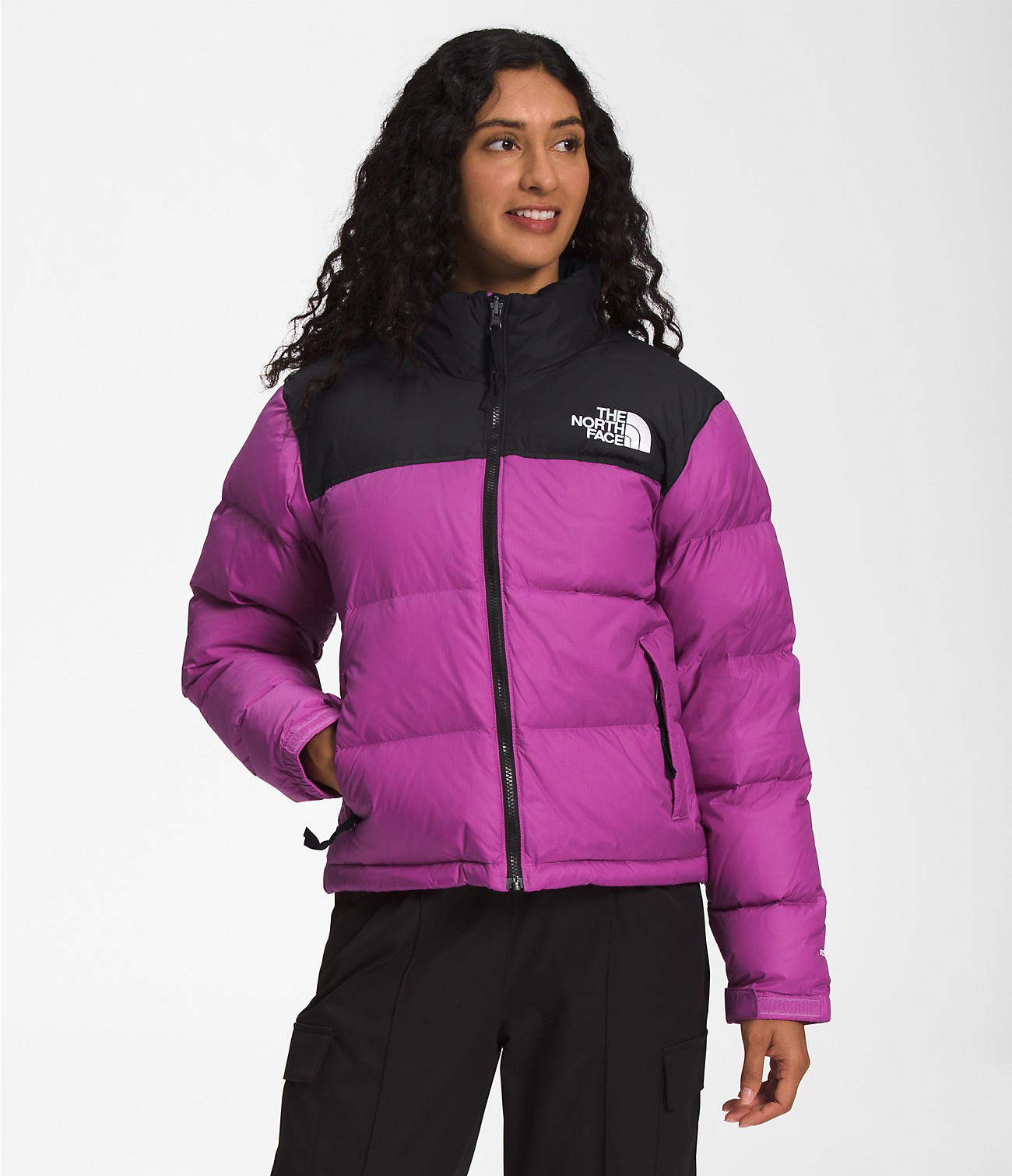
1996 Retro Nuptse Jacket by The North Face
Our rating: ★★★★★
Price: $$$$
A retro-inspired jacket designed for mountain and city life.
What makes it special? This retro design is not only stylish but also practical, with its water-repellent ripstop fabric and oversized baffles that provide exceptional warmth. One of the standout features of this jacket is its use of 700 fill goose down, which offers exceptional warmth and compressibility. Even with its thick insulation, the jacket is surprisingly lightweight, weighing in at just 685 g (1 lb 8.16 oz). The jacket's design is inspired by the iconic 1996 Nuptse jacket, with oversize logos that pay homage to its predecessor. The original shiny ripstop fabric also adds to the jacket's durability, while the non-PFC DWR finish ensures added water repellency. Additional features like the attached, stowable, three-piece hood, secure-zip hand pockets, and Triclimate loops make this jacket even more practical. Plus, with its relaxed fit and boxy silhouette, it's easy to layer over other clothing without feeling too bulky. Whether you're hitting the slopes or the city streets, this jacket will keep you dry, warm and comfortable- all while looking fantastic.
Final Verdict
In conclusion, when it comes to down and insulated jackets, both Kathmandu and North Face offer fantastic options. While each brand may offer different styles or features, it ultimately comes down to personal preference and individual needs.
If you're looking for a jacket that will keep you warm in the harshest of conditions, North Face may be the better choice for you. However, if you're after something that balances warmth and style, Kathmandu has plenty of options to choose from.
Regardless of which brand you choose, it's important to remember that the quality of the jacket will depend on the materials used and the construction of the garment. Both Kathmandu and North Face have proven track records when it comes to creating durable and reliable clothing.
So, at the end of the day, it's not about which brand is better than the other. Instead, it's about finding the jacket that fits your needs and budget. Both brands have their own unique strengths and offerings, which means that you really can't go wrong with either choice.
Related articles
Helly Hansen vs North Face (The Definitive Guide)
North Face vs Arcteryx (The Definitive Guide)
North Face vs Fjallraven (The Definitive Guide)
Columbia vs North Face (The Definitive Guide)
Patagonia vs North Face (The Definitive Guide)
North Face vs Tommy Hilfiger (The Definitive Guide)
Nike vs North Face (The Definitive Guide)
Osprey vs North Face (The Definitive Guide)
North Face vs Under Armour (The Definitive Guide)
Marmot vs North Face (The Definitive Guide)
Canada Goose vs North Face (The Definitive Guide)
Eddie Bauer vs North Face (The Definitive Guide)
Uniqlo vs North Face (The Definitive Guide)
North Face vs Mammut (The Definitive Guide)
Rab vs North Face (The Definitive Guide)
Mountain Hardwear vs North Face (The Definitive Guide)
Black Diamond vs North Face (The Definitive Guide)
Berghaus vs North Face (The Definitive Guide)
Carhartt vs North Face (The Definitive Guide)
Rei vs North Face (The Definitive Guide)
Merrell vs North Face (The Definitive Guide)
L.L. Bean vs North Face (The Definitive Guide)
Keen vs North Face (The Definitive Guide)
Timberland vs North Face (The Definitive Guide)
Dakine vs North Face (The Definitive Guide)
Haglofs vs North Face (The Definitive Guide)
Deuter vs North Face (The Definitive Guide)
Thule vs North Face (The Definitive Guide)
Karrimor vs North Face (The Definitive Guide)
Superdry vs North Face (The Definitive Guide)
Lululemon vs North Face (The Definitive Guide)
Craghoppers vs North Face (The Definitive Guide)
Stone Island vs North Face (The Definitive Guide)
Barbour vs North Face (The Definitive Guide)
Lands' End vs North Face (The Definitive Guide)
Moncler vs North Face (The Definitive Guide)
Adidas vs North Face (The Definitive Guide)
Montbell vs North Face (The Definitive Guide)
Oakley vs North Face (The Definitive Guide)
Kühl vs North Face (The Definitive Guide)
Napapijri vs North Face (The Definitive Guide)
Cotopaxi vs North Face (The Definitive Guide)
Decathlon vs North Face (The Definitive Guide)
Macpac vs North Face (The Definitive Guide)
Outdoor Research vs North Face (The Definitive Guide)
Spyder vs North Face (The Definitive Guide)
Herschel vs North Face (The Definitive Guide)
Eastpak vs North Face (The Definitive Guide)
Wantdo vs North Face (The Definitive Guide)
Hawke and Co vs North Face (The Definitive Guide)
Woolrich vs North Face (The Definitive Guide)
Geographical Norway vs North Face (The Definitive Guide)
Trespass vs North Face (The Definitive Guide)
Regatta vs North Face (The Definitive Guide)
Burton vs North Face (The Definitive Guide)
Mountain Equipment vs North Face (The Definitive Guide)
Obermeyer vs North Face (The Definitive Guide)
Point Zero vs North Face (The Definitive Guide)
Swiss Gear vs North Face (The Definitive Guide)
Mountain Warehouse vs North Face (The Definitive Guide)
Peak Performance vs North Face (The Definitive Guide)
North Face vs JanSport (The Definitive Guide)
North Face vs Aritzia (The Definitive Guide)
North Face vs Quecha (The Definitive Guide)